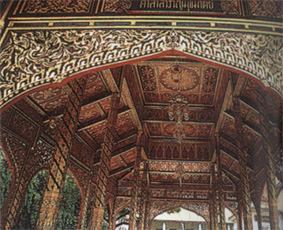|
|
|
The Arts
|
Traditional Manual Arts
During the Ayutthaya period
writers, painters, dancers, sculptors,
architects, musicians, and skilled
craftsmen came under the royal
patronage of kings and the nobility. Thai
architects and artists were responsible
for building and decorating palaces,
monasteries, and shrines in conventionally
acceptable forms and styles. Unlike their
Western counterparts, they were not
expected to display revolutionary
originality or inventiveness. Thus arts
anil craftsmanship were transmitted
from generation to generation according
to rigid discipline.
 |
Kinaree, mythological figure found in Thai decorations
|
In an attempt to provide general
training to Thai craftsmen, especially those
who worked in the palaces, the Krom Chang Sip Mu (Organization of the Ten
Crafts) was established. According to
Prince Pradit Worakam. who was placed
in charge of the Chang Sip Mu Department
during the reign of King Rama V, the
original organization in fact covered as
least 13 different cratsmen: drawers,
paper-in akers, engravers, figure-makers,
modellers, plasterers, lacquerers, metal
beaters, turners, moulders, wood-carvers.
sculptors, and carpenters.

Intricate carved and gilded wood panels
|
In the Bangkok period, these were
grouped into 10 divisions: drawing
(which included draughtsmen, painters,
muralists, and manuscript illustrators),
engraving (woodcarvers, engravers
on metal, precious metal inlay), turning
(lathe-workers, carpenters and joiners,
glass mosaic workers), sculpting (paper
sculptors, decorative fruit and vegetable
carvers), modelling (beeswax moulders
and bronze casters, mask and puppet
makers), figure-making (dummy and
prototype makers), moulding (craftsmen
in bronze and metal casting), plastering
(bricklayers, lime plasterers, stucco
workers and sculptors), lacquering
(masters of lacquerware and mother-of-pearl inlay), and beating (metal beaters
and finishers of metal articles).

Elaborate woodcarving, a feature of many traditional buildings
|
Contemporary Thai arts and crafts,
though modernized to some extent
through improved technology, are still
very much inspired by tradition. Ranging
from delicately wrought silverware to
numerous utilitarian items of everyday
life, they are part of the kingdom's rich cultural heritage.
 |
Gold-and-black lacquer adorns temple doors and windows
|
| | |
|
|